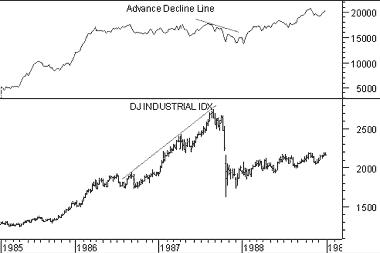
Technical Analysis from A to Z
by Steven B. Achelis
ADVANCE/DECLINE LINE
Overview
The Advance/Decline Line ("A/D Line") is undoubtedly the most widely used measure of market breadth. It is a cumulative total of the Advancing-Declining Issues indicator. When compared to the movement of a market index (e.g., Dow Jones Industrials, S&P 500, etc) the A/D Line has proven to be an effective gauge of the stock market's strength.
Interpretation
The A/D Line is helpful when measuring overall market strength. When more stocks are advancing than declining, the A/D Line moves up (and vice versa).
Many investors feel that the A/D Line shows market strength better than more commonly used indices such as the Dow Jones Industrial Average ("DJIA") or the S&P 500 Index. By studying the trend of the A/D Line you can see if the market is in a rising or falling trend, if the trend is still intact, and how long the current trend has prevailed.
Another way to use the A/D Line is to look for a divergence between the DJIA (or a similar index) and the A/D Line. Often, an end to a bull market can be forecast when the A/D Line begins to round over while the DJIA is still trying to make new highs. Historically, when a divergence develops between the DJIA and the A/D Line, the DJIA has corrected and gone the direction of the A/D Line.
A military analogy is often used when discussing the relationship between the A/D Line and the DJIA. The analogy is that trouble looms when the generals lead (e.g., the DJIA is making new highs) and the troops refuse to follow (e.g., the A/D Line fails to make new highs).
Example
The following chart shows the DJIA and the A/D Line.

The DJIA was making new highs during the 12 months leading up to the 1987 crash. During this same period, the A/D Line was failing to reach new highs. This type of divergence, where the generals lead and the troops refuse to follow, usually results in the generals retreating in defeat as happened in 1987.
Calculation
| Table 2 | ||||
| Date | Advancing | Declining | A-D | A/D Line |
|---|---|---|---|---|
| 02/15/94 | 1198 | 882 | 316 | 316 |
| 02/16/94 | 1183 | 965 | 218 | 534 |
| 02/17/94 | 882 | 1251 | -369 | 165 |
| 02/18/94 | 706 | 1411 | -705 | -540 |
| 02/22/94 | 1139 | 1003 | 136 | -404 |
Because the A/D Line always starts at zero, the numeric value of the A/D Line is of little importance. What is important is the slope and pattern of the A/D Line.
Contents
- Preface
- Acknowledgments
- Terminology
- To Learn More
- Bibliography
- About the Author
- Technical Analysis
- Price Fields
- Charts
- Support & Resistance
- Trends
- Moving Averages
- Indicators
- Market Indicators
- Line Studies
- Periodicity
- The Time Element
- Conclusion
- Absolute Breadth Index
- Accumulation/Distribution
- Accumulation Swing Index
- Advance/Decline Line
- Advance/Decline Ratio
- Advancing-Declining Issues
- Advancing, Declining, Unchanged Volume
- Andrews' Pitchfork
- Arms Index
- Average True Range
- Bollinger Bands
- Breadth Thrust
- Bull/Bear Ratio
- Candlesticks - Japanese
- CANSLIM
- Chaikin Oscillator
- Commodity Channel Index
- Commodity Selection Index
- Correlation Analysis
- Cumulative Volume Index
- Cycles
- Demand Index
- Detrended Price Oscillator
- Directional Movement
- Dow Theory
- Ease of Movement
- Efficient Market Theory
- Elliott Wave Theory
- Envelopes (Trading Bands)
- Equivolume/Candlevolume
- Fibonacci Studies
- Four Percent Model
- Fourier Transform
- Fundamental Analysis
- Gann Angles
- Herrick Payoff Index
- Interest Rates
- Kagi
- Large Block Ratio
- Linear Regression Lines
- MACD
- Mass Index
- McClellan Oscillator
- McClellan Summation Index
- Median Price
- Member Short Ratio
- Momentum
- Money Flow Index
- Moving Averages
- Negative Volume Index
- New Highs-Lows Cumulative
- New Highs-New Lows
- New Highs/Lows Ratio
- Odd Lot Balance Index
- Odd Lot Purchases/Sales
- Odd Lot Short Ratio
- On Balance Volume
- Open Interest
- Open-10 TRIN
- Option Analysis
- Overbought/Oversold
- Parabolic SAR
- Patterns
- Percent Retracement
- Performance
- Point & Figure
- Positive Volume Index
- Price and Volume Trend
- Price Oscillator
- Price Rate-of-Change
- Public Short Ratio
- Puts/Calls Ratio
- Quadrant Lines
- Relative Strength, Comparative
- Relative Strength Index
- Renko
- Speed Resistance Lines
- Spreads
- Standard Deviation
- STIX
- Stochastic Oscillator
- Swing Index
- Three Line Break
- Time Series Forcast
- Tirone Levels
- Total Short Ratio
- Trade Volume Index
- Trendlines
- TRIX
- Typical Price
- Ultimate Oscillator
- Upside/Downside Ratio
- Upside/Downside Volume
- Vertical Horizonal Filter
- Volatility, Chaikin's
- Volume
- Volume Oscillator
- Volume Rate-of-Change
- Weighted Close
- Williams' Accumulation/Distribution
- Williams' %R
- Zig Zag